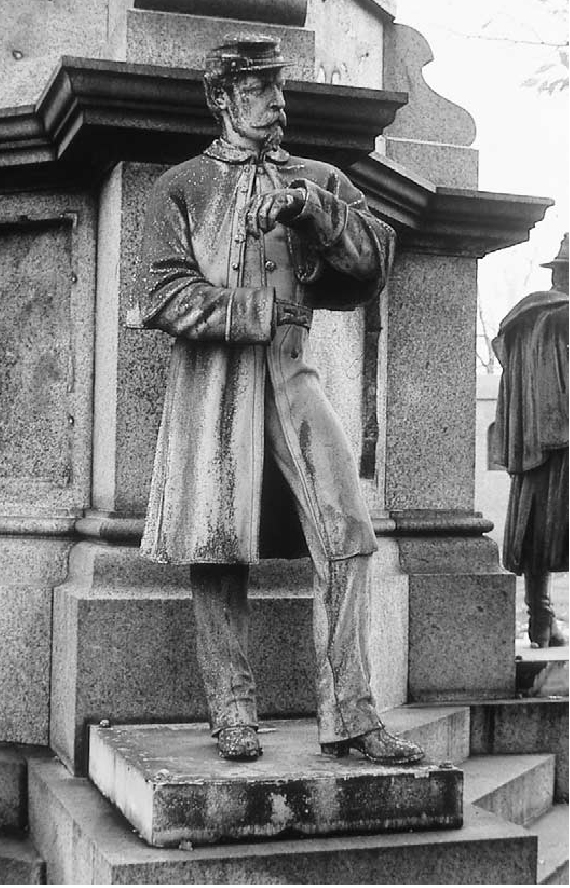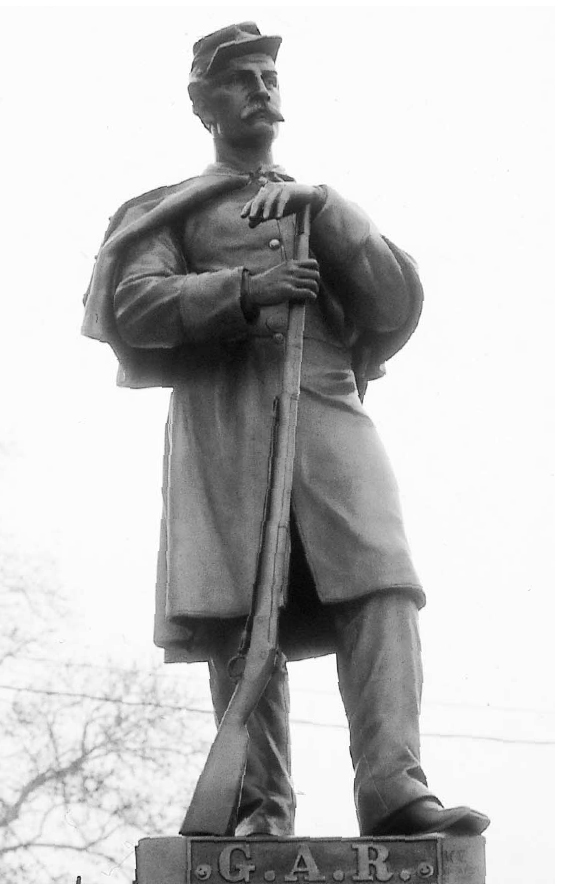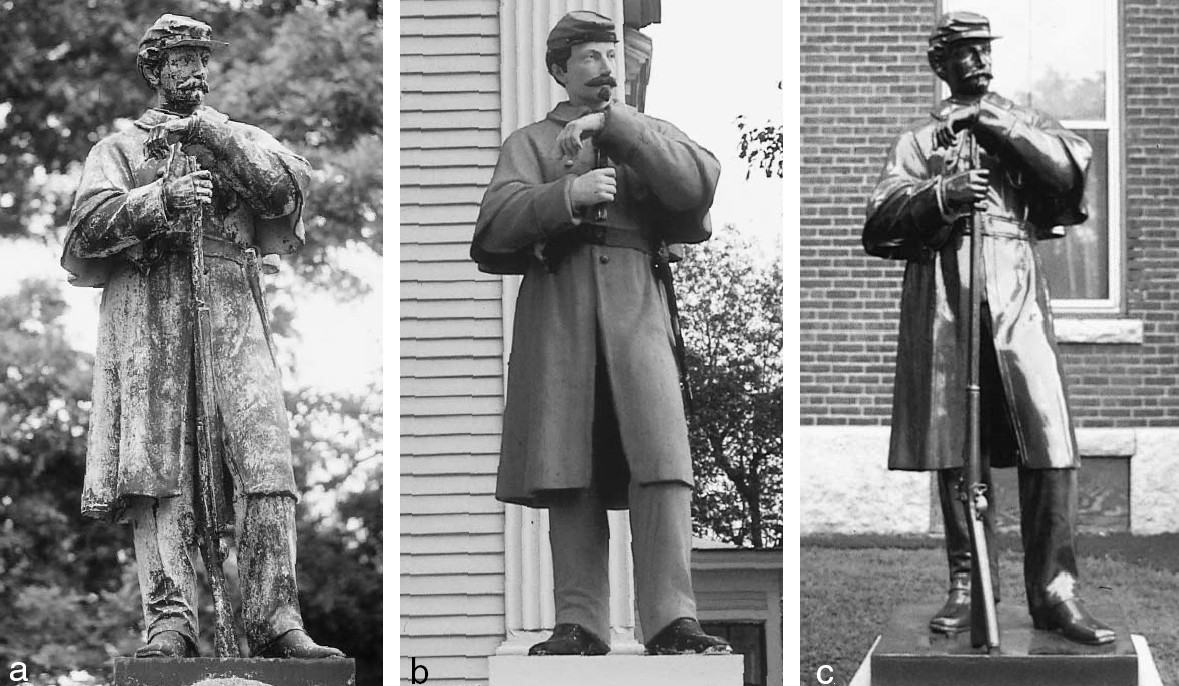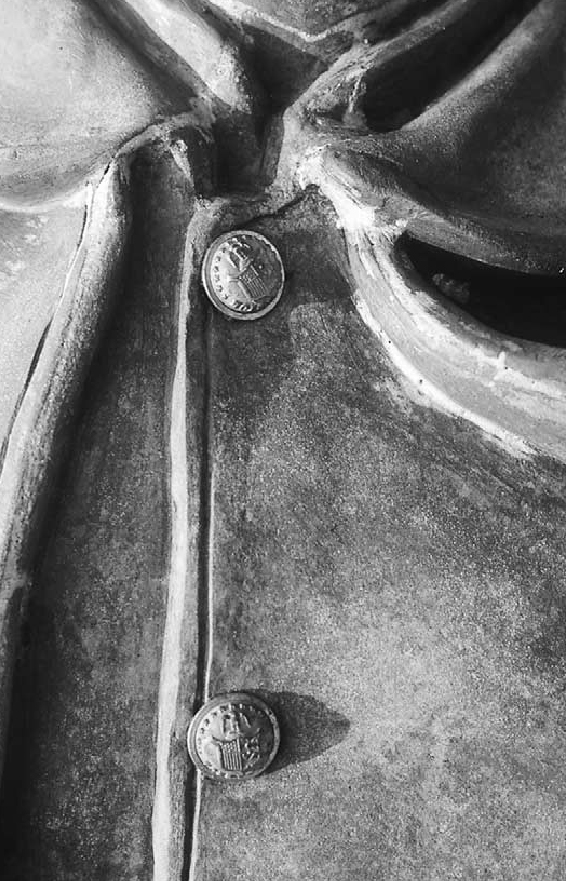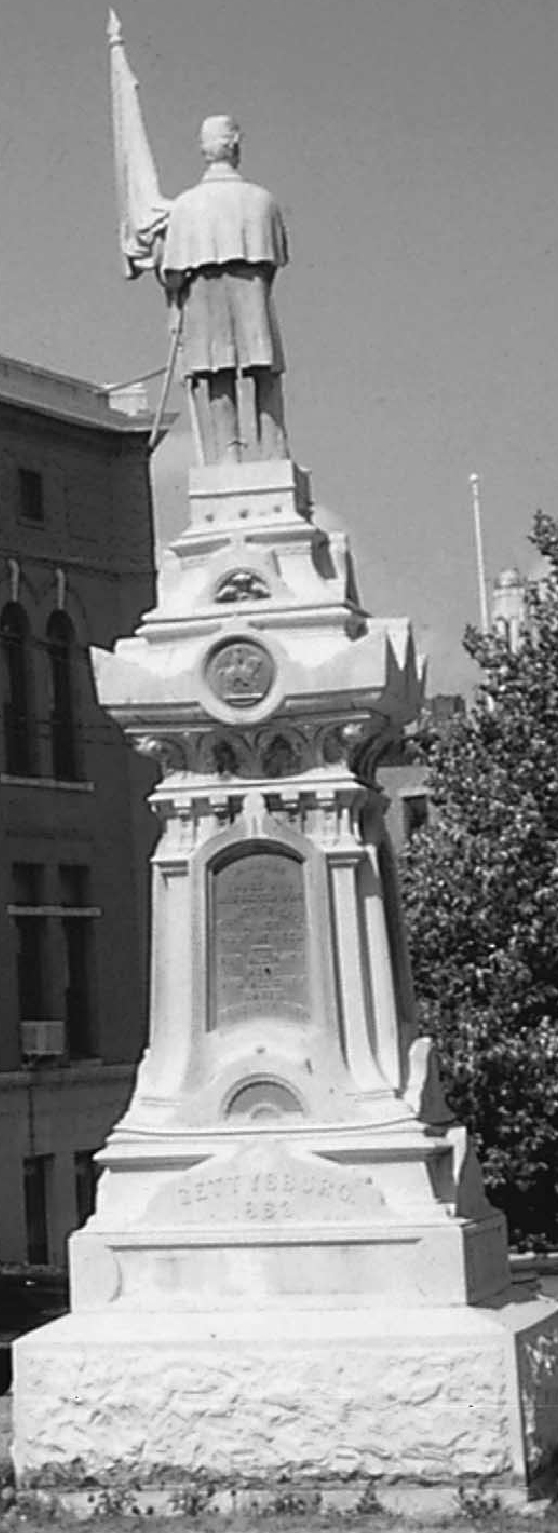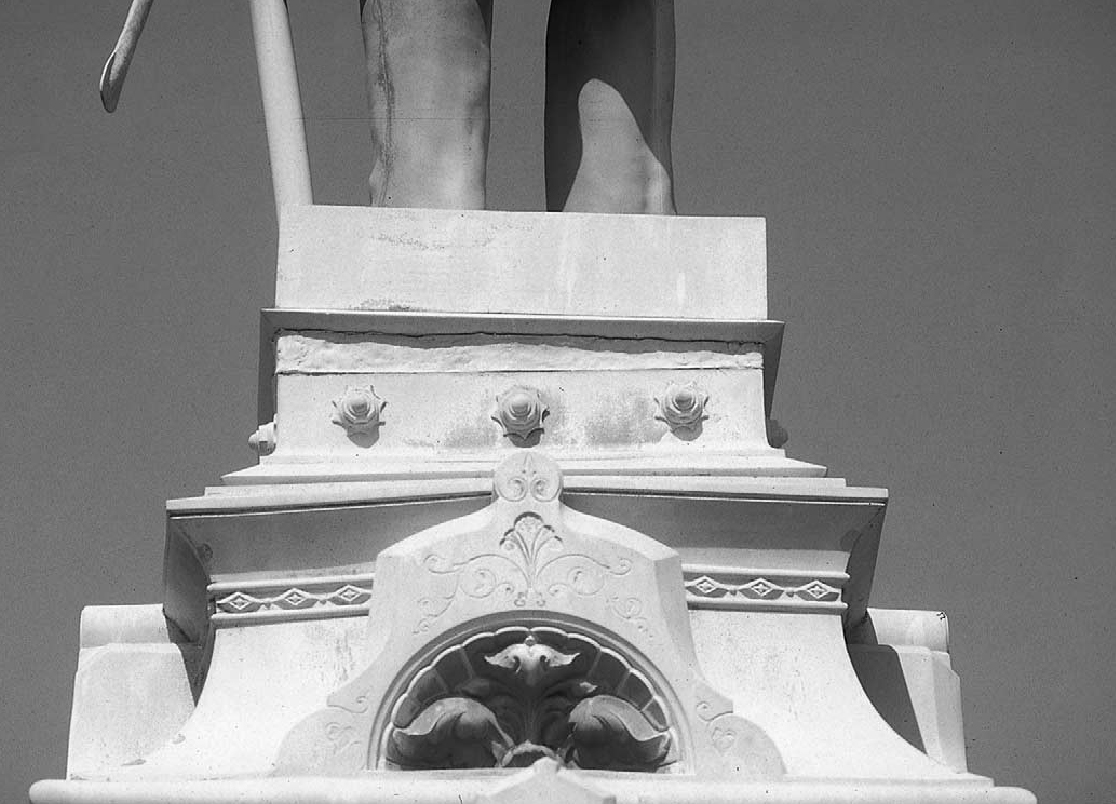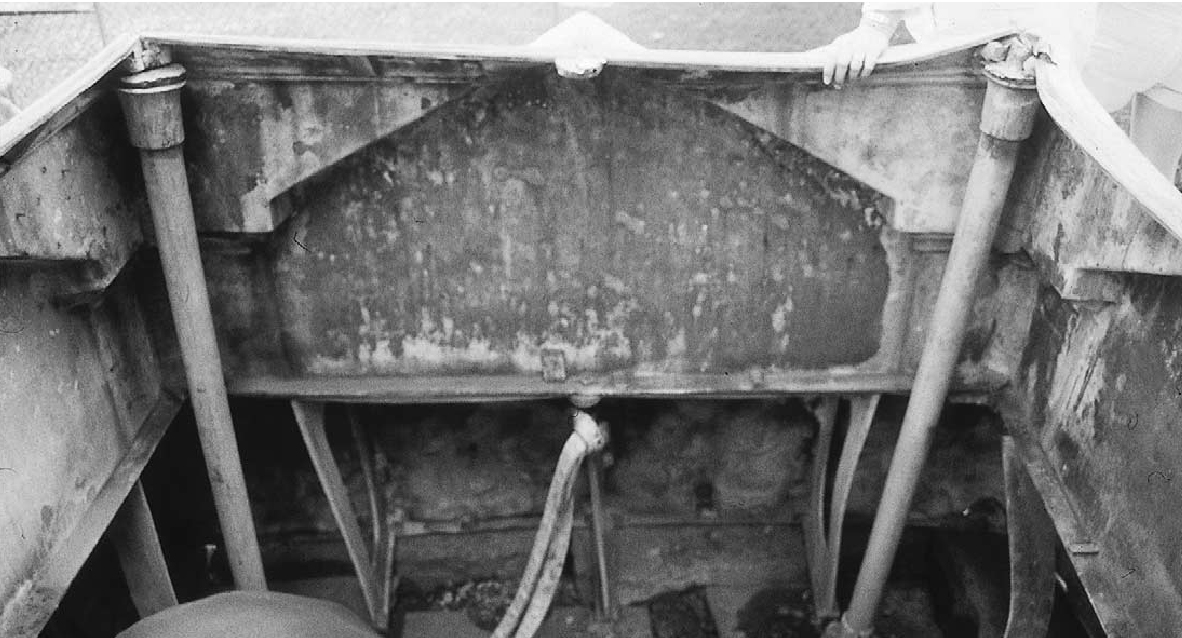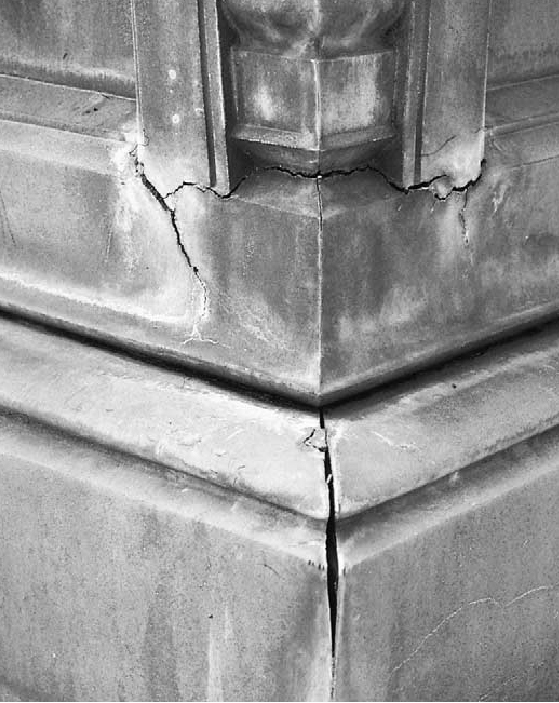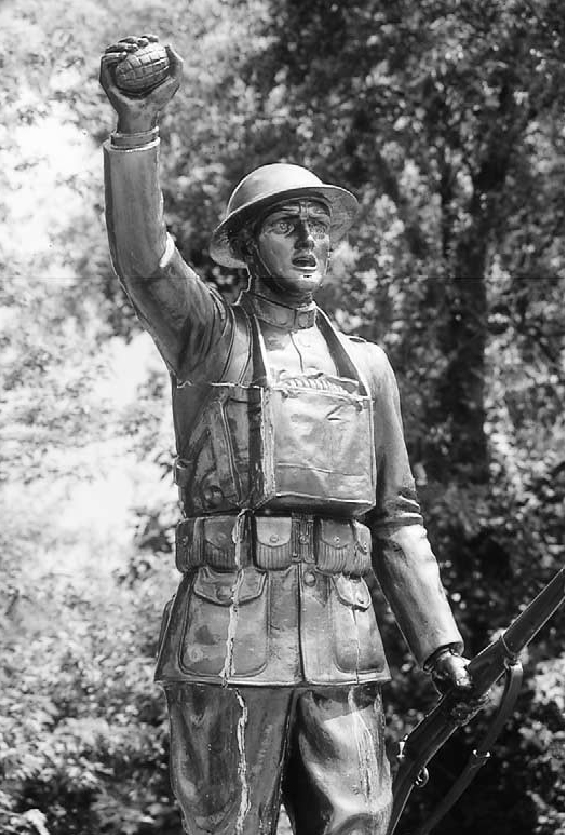THE CONSERVATION OF AMERICAN WAR MEMORIALS MADE OF ZINCCAROL A. GRISSOM, & RONALD S. HARVEY
ABSTRACT—Affordable war memorials featuring soldiers made of zinc were purchased by small towns throughout the United States following the Civil War, and the practice continued to a lesser extent after the Spanish-American and First World Wars. Such memorials can be generally divided into three groups defined by fabrication techniques: (1) imitation bronze statues sand-cast in pieces, assembled by soldering, painted with “bronze” paint, and placed on masonry pedestals or cast-iron fountains; (2) so-called white-bronze statues assembled using molten zinc to back unobtrusively located joins between sand-cast pieces, sandblasted to appear stonelike, and displayed on masonry pedestals or multilayered white-bronze bases that in some cases created enormous monuments made entirely of zinc; and (3) statues stamped from sheet zinc in sections, which were soldered or riveted together on metal armatures and painted. The most common zinc statue damage is breakage of the brittle cast metal. Difficult problems are presented by large white-bronze monuments, which are often distorted by the metal's tendency to creep. Even more damage has been caused by ill-informed attempts at amelioration, especially filling interiors with concrete instead of installing stainless steel internal supports. Appropriate surface treatments are emphasized. TITRE—La conservation des c�notaphes et autres monuments aux morts am�ricains faits en zinc. R�SUM�—Suivant la guerre civile, des petites villes dans l'ensemble des �tats-Unis se sont procur�s des monuments aux morts comportant des soldats faits en zinc, le prix de ces monuments �tant relativement peu dispendieux. Cette m�me pratique s'est aussi r�p�t�e, quoiqu'� un degr� moindre, suivant la guerre hispano-am�ricaine et la Premi�re Guerre Mondiale. En g�n�ral, ces monuments peuvent �tre divis�s en trois cat�gories d�finies par leurs techniques de fabrication. Premi�rement il y a les statues en imitation de bronze, qui sont coul�es pi�ce par pi�ce dans des moules en sable et ensuite assembl�es par soudure, peintes avec de la bronzine et enfin �rig�es sur des pi�destaux de ma�onnerie ou des fontaines en fonte. Deuxi�mement il y a les pr�tendues statues en bronze blanc, qui sont elles aussi coul�es pi�ce par pi�ce dans des moules en sable, mais sont assembl�es de fa�on discr�te en utilisant du zinc liquide sur le verso des joints. Ces statues sont ensuite soumises au jet de sable pour leur donner l'aspect de la pierre et �rig�es soit sur des pi�destaux de ma�onnerie, soit sur des bases faites de plusieurs couches de bronze blanc, ce qui cr�e dans certains cas d'�normes monuments enti�rement faits de zinc. Troisi�mement il y a les statues compos�es de feuilles de zinc estamp�es, qui ont �t� soud�es ou rivet�es ensemble sur des armatures en m�tal et finalement peintes. Les dommages les plus fr�quents sur ces statues en zinc sont caus�s par la rupture du m�tal de fonte qui est relativement cassant. Les grands monuments en bronze blanc pr�sentent souvent des probl�mes de d�formation d�s � la longue au fluage du m�tal sous l'action de la gravit�. Enfin bien d'autres dommages ont �t� provoqu�s par des tentatives inconsid�r�es de restauration, particuli�rement le bouchage avec du b�ton, au lieu d'installer des renforts internes en acier inoxydable. Des traitements de surface appropri�s sont d�crits, en soulignant leur importance. TITULO—Conservaci�n de monumentos americanos conmemorativos de guerra hechos de zinc. RESUMEN—Monumentos conmemorativos de guerra hechos de zinc que representan soldados fueron adquiridos a precios razonables por ciudades peque�as a trav�s de los Estados Unidos despu�s de la Guerra Civil. Esta pr�ctica continu� en menor medida despu�s de la guerra Hispano-Americana y de la Primera Guerra Mundial. Generalmente, estos monumentos conmemorativos pueden dividirse en tres grupos de acuerdo a su t�cnica de fabricaci�n: (1) estatuas imitaci�n bronce, fundidas en partes en moldes de arena, ensambladas por medio de soldaduras, pintadas con pintura de “bronce,” y situa-das en pedestales de mamposter�a o fuentes de hierro de fundici�n; (2) estatuas fabricadas usando el llamado “bronce blanco”, ensambladas usando zinc fundido para reforzar disimuladamente las uniones 1 INTRODUCTIONIn the Western world, successful large-scale smelting of zinc began in the 18th century. Statues were first made of zinc in Berlin during the 1830s, promoted by the influential German architect Karl Friedrich Schinkel (1781–1841). They were modeled by famous sculptors and placed in prestigious locations—the pediment of the Berlin Opera, for example, and throughout the gardens and royal palace of Sans Souci at Potsdam—and they proliferated in Central European cities, especially Berlin, Munich, Dresden, Vienna, and Budapest (V�sgen 1997; Kobler 1999; Hierath 2000). Following the revolution of 1848, a few German sculptors immigrated to the United States, where they played critical roles in early zinc production. One such immigrant, Moritz J. Seelig (1809–ca. 1889), produced the first recorded zinc castings in America for the Castle Garden Fair in New York in 1852 (Stiles 1884). Among the earliest extant statues is a zinc Benjamin Franklin (1858) purchased with a bronze finish for a niche on the Franklin Lyceum in Providence, Rhode Island (Danielson 1858). A cast-iron fountain decorated with zinc statues was installed in Savannah, Georgia, that same year. Trade catalogs featuring zinc statues appeared after the Civil War (Fiske ca. 1868–69), becoming longer and more lavish publications in the 1870s (Mott 1873; Fiske 1874; Seelig 1876). In 1876 the Centennial Exhibition in Philadelphia provided a showcase for zinc, and displays of zinc statuary by the J. L. Mott Iron Works and Wm. Demuth & Co. received commendations (Sandhurst et al. 1879; Walker 1880). Cast-zinc architectural sculptures also appeared on exhibition buildings, including seven colossal personifications and 16 huge eagles atop Memorial Hall (Sellin 1974). A large Gambrinus, the king who purportedly first brewed beer, stood over the entrance to Brewers Hall (Harris 2000). Stamped sheet-zinc eagles appeared on a Sheet-metal Pavilion (Sheet-metal Builder 1876). Initially, many zinc statues in the United States were copies of antique and other well-known European statues. American subjects soon dominated the market, however, including cigar store–type Indians, a Boy with a Leaking Boot, firemen, and Civil War soldiers. At least 100 Union and 25 Confederate soldiers made of zinc have survived. Unlike bronze soldiers, whose price tags could exceed $10,000, soldiers of zinc could be purchased for as little as $150 (Mott 1890). Most were placed in front of county courthouses in the Midwest, on the public commons of New England villages, or in small-town cemeteries as far west as Carson City, Nevada, or Redwood City, California. Their distribution has had ramifications for the present day, as conservation expertise may not be readily available in the smaller communities where zinc soldiers are located. Only 12 soldiers of zinc memorializing later wars have been located, as the use of zinc for statuary declined after 1900, in tandem with the decrease in popularity of public monuments in general. Still, the founder of Hershey's Chocolate, Milton Hershey, purchased a “bronzed” Rough Rider for $245 (Mott 1913), an inexpensive version of a popular bronze Spanish-American War Soldier (1904) by Allen George Newman (1875–1940). World War I soldiers made of zinc include three copies of a handsome Doughboy sold by the J. W. Fiske Iron Works. They appeared on memorials within a dozen miles of each other in northern New Jersey (Wanaque and Riverdale) and southern New York (Suffern) during the 1920s. The last known installation of a zinc soldier was a copy of Knowledge of fabrication always underlies sound conservation treatment. Since there is so little published material about the manufacture of zinc soldiers, this article provides considerable detail. Information about the entire body of zinc soldiers, gleaned in the process of compiling a catalog of zinc sculpture in America (Grissom forthcoming), shows that most are replicas of a few models. Their sculptors have not been identified to date, but a few names can be put forward here, including that of the Bohemian-born immigrant sculptor Caspar Buberl (1834–1899). In marked contrast to their German contemporaries, major American-born sculptors shunned zinc in favor of bronze or marble (Ward 1874). Further data about many individual sculptures mentioned in the text may be found at the invaluable website of the Smithsonian's Inventory of American Sculpture (www.siris.si.edu). 2 FABRICATIONThe principal advantage of using zinc for monuments was that this dull, gray metal could inexpensively be made to imitate bronze or stone. Application of paint or other surface treatments, however, made zinc an “invisible” metal. Today zinc remains almost unknown to the general public and even to conservation professionals. Zinc statues are frequently misidentified as lead or cast iron since all three are “white” metals. In fact, lead can be readily differentiated because it is easily scratched, and iron can be distinguished because it is magnetic. Cast iron was zinc's chief competitor for low-cost statuary in America. At first, zinc fountain statues like Antonio Canova's (1757–1822) Hebe, first produced in marble in 1796, probably copied cast-iron statues made slightly earlier by companies like the Philadelphia firm of Robert Wood & Company (Hinckley 1853). Use of zinc for fountain statues quickly superseded cast iron, however, because zinc was so easily cast and joined with ordinary lead-tin solder. Before the development of welding at the end of the 19th century, cast-iron statues had to be laboriously made by bolting pieces together; alternatively, they could be cast whole, which required complex molding or pattern making. Cast iron remained in use for statuary only when its advantages of weight and strength were important. For instance, Jockey, Chinaman, and Darkey hitching posts were made exclusively of cast iron. Identical statues cast in zinc had more limited uses as trade signs for stables and teahouses, as well as for the New York City premises of the statue's purveyor, J. W. Fiske (Fried 1970). Cast-iron animal statues also may have continued to outnumber their zinc counterparts because their ruggedness made them more suitable for display on lawns. American zinc statues were fabricated using three techniques. The most common was to assemble small sand-cast pieces with lead-tin solder. Surfaces of soldiers fabricated in this way were almost invariably painted to simulate bronze. A second type of statue was described by its producers as made of so-called white bronze, a material distinct from real (copper alloy) bronze. White bronze was produced only by the Monumental Bronze Company in Bridgeport, Connecticut, or affiliates with similar names and mostly used for tombstones and cemetery statues. White-bronze statues were carefully made so that joins were unobtrusive, and surfaces were sandblasted to achieve matte finishes that had the “appearance of a superior sort of stone” (Schuyler 1878, 7). A third technique, stamping statues in sheet zinc, was used mostly for architectural statues. These could be purchased for even less than cast statues. Only one sheet-zinc soldier has been located, however, probably because identical soldiers made from sheet copper could be purchased for only a little more money. Supporting armatures are always found inside sheet-zinc statues, while they are rarely used inside those made of cast zinc. 2.1 PAINTED CAST-ZINC STATUESContemporaneous publications describing fabrication of painted cast-zinc statues in America are almost nonexistent. The archives and recollections of The earliest known zinc soldiers were made for the City of New York Civil War Monument (1869) in Brooklyn's Green-Wood Cemetery: an Infantryman (fig. 1), Cavalryman, Artilleryman, and Engineer. Contemporaneous photographs and remnants of copper plating provide solid evidence that the statues originally imitated bronze (Richman 1998). Moreover, the statues are replicas of four bronze statues on an earlier City of New York Civil War Monument (1866) at Calvary Cemetery in Queens. While no further copies of three statues are known, the Infantryman was a popular figure standing at parade rest, wearing a greatcoat, and steadying his rifle with the fingers of his left hand dangling over the end of the barrel. The statue was reproduced at least once in zinc (for White Plains, New York) and four times in bronze (for Wilmington, North Carolina; Ossining, New York; and Clinton, and Lawrence, Massachusetts). It also seems to have been the model for two slightly different versions sold through trade catalogs in later decades (see below). M. J. Power (1836–1902) cast the bronze statues for the City of New York Monument in Calvary Cemetery, and later bronze copies of the Infantryman bear his foundry mark. The founder for the zinc statues at Green-Wood Cemetery is undocumented, but Seelig is the most likely candidate. During the 1850s the immigrant sculptor had established a zinc foundry in Williamsburg, just across the East River from New York City, and verbal tradition among his descendants supports attribution of the soldiers to his foundry (Sammel 2002). The sculptor is unknown, but the statues bear considerable resemblance to the work of Buberl. Moreover, Buberl is known to have worked with Power and modeled several zinc statues cast by Seelig, including a colossal Robert Fulton (1872) for the Fulton Ferry landing in Brooklyn, now in the Museum of the City of New York. Recent bronze replication afforded an opportunity for close examination of the Green-Wood Cemetery statues at Modern Art Foundry in Queens, New York. During deinstallation at the cemetery, the
In subsequent decades, slightly different versions of the Green-Wood Cemetery's Infantryman were sold through catalogs by J. W. Fiske and the J. L. Mott Iron Works, known in about 10 copies each. Principally purveyors of utilitarian ironwork, the two New York City companies had sidelines in fountains with cast-iron basins that incorporated zinc statues, and they marketed individual zinc statues as well. Both companies seem to have obtained statues from a zinc foundry, which cast their models, sold them statues “off the shelf,” or both. J. W. Fiske used M. J. Seelig & Co. for casting statues by 1892 (Seelig 1892; Fiske 2000), and in 1927 Seelig scrapped Fiske's patterns for the Civil War Soldier on the company's behalf (Seelig 1927). No documentation has been found regarding Mott's source for zinc statues, but nearly all statues in a Mott catalog of 1873 are listed in a contemporaneous Seelig catalog (1876), supporting the Seelig foundry as the source during those years. J. W. Fiske's soldier (fig. 2) was almost certainly modeled before the Mott statue, since the 1875 dedication of a copy in Saratoga, New York, is well documented. The name of the statue's modeler—Allicot—has been found in Fiske family papers (Fiske 1941) and can be plausibly identified with Henry J. Ellicott (1848–1901) since the statue resembles other works by the sculptor, e.g., the First Pennsylvania Cavalry Monument (1890) at Gettysburg. The figure
J. W. Fiske's statues were mainly cast in sand using zinc patterns, which could be used an almost unlimited number of times (Wilkinson 1871). Cast-iron piece molds were also made for slush-casting portions of Fiske's statues, such as a small head, although there is no evidence of this form of manufacture in the case of Fiske's soldier (Fiske 2000). The patternmaker placed seams where it was convenient for molding and casting instead of where they would be unobtrusive, since statues were to be painted. From the 1930s until zinc statues were no longer sold by the company in the 1950s, cast pieces arrived from the foundry at Fiske's Manhattan offices packed in burlap bags inside wooden barrels (Fiske 2000). There, facilitated by marks that had been struck across joins on interior surfaces of the patterns, they were soldered together by workmen in the subbasement. Mott's statues are similar to those of Fiske in terms of fabrication, and soldiers sold by both companies were customized with genuine gilt-brass army buttons soldered to the zinc. Presumably obtained by the foundry from those available in New York City, buttons on a J. W. Fiske statue in Pottstown (fig. 4) are those of New York state militia rather than the local Pennsylvania regiment (Albert 1976). Both Mott and Fiske soldiers were available “painted one coat” (probably a primer) or, for a slightly higher price, “bronzed” (Mott 1890, 1901, 1911; Fiske ca. 1908–15). According to 19th-century documents, Fiske sent a workman to “bronze” a fountain on-site in the New York area (Fiske 1893), and analyses have shown that this treatment consisted of the successive application of white lead paint, reddish brown paint, and copper flakes in a clear medium, topped by varnish (Grissom 1994). Microscopic examination of original bronze paint from the Pottstown soldier revealed three layers, with the middle layer containing copper flakes dusted on still-wet lacquer (Lins 1996). From at least the 1930s through the 1950s, statues were painted in Fiske's
2.2 WHITE-BRONZE MONUMENTSWhite-bronze monuments and statues were sold only by the Monumental Bronze Company; its predecessor, Schuyler, Parsons, Landon, & Co.; and affiliates: the Detroit White Bronze Company; the Philadelphia White Bronze Company; the American Bronze Company in Chicago; the Western White Bronze Company in Des Moines, Iowa; and the St. Thomas White Bronze Company in St. Thomas, Ontario (Rotundo 1989). White bronze was promoted as the latest scientific achievement, and articles about it appeared in contemporary scientific journals (Scientific American 1885; Saw 1910). Considerable documentation of the companies' unique fabrication processes is also provided in advertising (Schuyler 1878; Monumental Bronze 1882; American Bronze ca. 1891; Western White Bronze 1893). The following is taken from the American Bronze Company (ca. 1891, 9) catalog:
Joining zinc with zinc is unusual, not otherwise done in the United States or Europe. Molten zinc does not adhere well to cast zinc, and the deposits of molten metal had to be quite thick in order for pieces to be successfully joined. Sometimes the strategy seems to have been to key pieces in place mechanically. During treatment at Modern Art Foundry, for instance, a Confederate soldier from Suffolk, Virginia, was found to have 20 cm of solid metal inside the lower legs, apparently for attaching it to the base. The underside of the base revealed that a cast-zinc bar had By far the most popular white-bronze statue was referred to in the Monumental Bronze Company's catalog as an American Soldier, depicted standing at parade rest but now with both hands around the barrel of his rifle (fig. 5). More than 60 Union and 2 Confederate white-bronze copies of the American Soldier were erected between 1877 and 1913. The statue is an awkward version of bronze soldiers available shortly after the end of the Civil War, including those by Martin Milmore (1844–1881) in New England towns, Randolph Roger's (1825–1892) Infantryman for the Michigan Soldiers' and Sailors Monument in Detroit (1867), and J. Q. A. Ward's (1830–1910) Seventh Regiment Memorial (1869) placed in New York's newly created Central Park. Somewhat less popular was a white-bronze statue of a Colorbearer holding onto the staff of a large upright flag with his left hand, a drawn sword in the other hand. It is known in 11 copies dedicated from 1886 to 1908 (figs. 6, 7). Since white bronze appears bluish
One of the most unusual aspects of white-bronze Civil War statues is that more than half were displayed atop imitation-stone bases also made of white bronze (see figs. 5, 6). In some cases this combination resulted in monuments more than 12 meters in height. The use of zinc for such large structures is unique. Nothing this ambitious was attempted in Europe, although zinc was used more extensively in Central Europe for both statuary and architecture. These white-bronze bases consist of three to six sections, each square in plan, including columns, Corinthian capitals, and sections customized with inscriptions or low-relief illustrations. The lowest section almost invariably was modeled in imitation of rough-hewn rock, sometimes with a foundry inscription in raised letters on the back face. Each section was made by fusing the corners of its four sides with thick deposits of zinc. Sections were kept separate for easy transport and assembly on-site. Typically, white-bronze monuments were placed without attachment on simple footings. Sometimes these consisted of as little as a single course of stone placed on the ground. Starting from the bottom, as sections were added, each was bolted to the adjacent section on the inside center of each face. The final step was to place the statue on top. It was usually attached on center through the self-base, using brass bolts covered by decorative white-bronze heads. Original supports are minimal inside all large white-bronze monuments that have been examined (fig. 8). Several vertical cast-zinc stiffener plates were attached at the foundry inside each face of the lowest
2.3 SHEET-ZINC SOLDIERSStamped sheet-zinc statues are readily distinguished from cast statues by their thinness, light weight, smooth surfaces, and susceptibility to denting. Identical models were available stamped in zinc, copper, brass, or bronze sheet through trade catalogs that featured architectural metalwork. The earliest known model of a sheet-metal soldier, a Soldier on Guard, appeared in a Bakewell & Mullins catalog in 1887. By 1897, eight soldiers are found in a catalog of the Friedley & Voshardt Company. Many models are almost exact copies of earlier cast-zinc statues, including the Green-Wood Cemetery–type Infantryman and white-bronze statues of the American Soldier and Colorbearer. While extant sheet-copper or sheet-bronze soldiers are relatively common, only one sheet-zinc soldier has been located, a W. H. Mullins Company (1913)Confederate Infrantryman at Parade Rest on the Confederate Monument (1891) in Georgetown, South Carolina. Two sheet-zinc statues in Paducah, Kentucky, are known as The Blue and The Gray but were actually sold by the Friedley & Voshardt Company as School Boys. By 1896, statues stamped from copper-alloy sheets cost little more than zinc (Mullins 1896), and in 1913, when the W. H. Mullins Company issued a beautifully bound catalog of sheet-metal soldiers for the 50th anniversary of the Gettysburg battle, only sheet-copper and bronze statues are illustrated. At the most active architectural sheet-metal company, W. H. Mullins, dies for stamping were made from plaster models. The lower die was made of cast zinc, and the upper die of lead. Sheet metal was heated, then placed between the dies and smashed into shape with a drop hammer (Lemonte 1947). The stamped pieces were then riveted or soldered
3 DETERIORATIONZinc war memorials are typically more well cared for than other zinc sculptures in the public domain because they have organized advocates in veterans' groups. Surrounding areas tend to be landscaped and regularly decorated with flags and wreaths, even in winter amid snow. Vandalism seems to occur less often, prevented also by the fact that many soldiers are relatively inaccessible on tall pedestals. Zinc war memorials are also more likely than other zinc statues to be repaired when damaged. Unfortunately, frequent repairs sometimes accelerate damage when choices of conservation techniques are ill-informed. The most common reason that a zinc soldier is brought to the attention of a conservator is breakage. Cast zinc is far more brittle than bronze, and when cast-zinc statues fall from pedestals, the metal is often described as having “shattered.” Jagged fractures run across zinc fragments, typically revealing at their edges the large metallic grains that form as zinc cools in sand molds. Close examination usually shows that seams have also come apart, probably because there were incipient cracks. Lead-tin solder seams are often found cracked on statues that appear intact, and white-bronze joins tend to separate over time One of the unfortunate properties of zinc is that it creeps (deforms over time) under its own weight. As a result, life-size cast-zinc statues may exhibit lean when the center of gravity is eccentric to the center of the statue's base. White-bronze soldiers seem to be damaged by this phenomenon more often than their painted counterparts. The Colorbearer, for instance, invariably leans toward the eccentrically placed flag (steps taken to compensate for one example's lean are visible in fig. 7). The American Soldier often sinks into the base at his right heel, causing the statue to lean backward and slightly to the figure's right. While a downward deflection of one cm at the heel appears slight, the concomitant lateral deflection of some 6 cm at the head of a life-size statue is visually disturbing as well as cause for alarm (see fig. 5). On account of their size and weight, the multitiered white-bronze bases often exhibit more perilous structural problems resulting from creep. The metal skin may sag downward where unsupported by an armature, and it often bulges outward at the base. Cracks occur at the interface of thick and thin areas adjacent to joins. For example, vertical cracks are often found about 5 cm from the corners on the base. Galvanized-iron columns have been found out-of-vertical and no longer supporting the corners of the monument, and stiffener plates have buckled as weight was transferred to them (see fig. 8). Well-intentioned treatments to improve support may lead to greater damage, especially the all-too-frequent partial or complete filling of monument bases with concrete. Concrete shrinks upon setting, typically leaving narrow gaps between the fill and metal. Water eventually finds its way to the gaps and places enormous pressure on the metal as it expands with freezing. Severe cracking results, accompanied by the accumulation of concrete exudates on adjacent surfaces (fig. 9). In a few instances, damaged portions of monuments have been removed, leaving the monuments truncated. For instance, the once-magnificent nearly 13 meter high Soldiers and Sailors Monument (1888) in Portsmouth, New Hampshire, is now missing two middle sections and about 5 meters of its original height. While concrete has been used less frequently to fill the statues themselves, results are similar. Other fillers can cause problems as well, such as a plasterlike material inside the Doughboy in Verona, Pennsylvania (fig. 10). Zinc forms reasonably stable corrosion layers except when atmospheres contain significant sulfur or chlorine (Grissom 1994). Even, light blue-gray patinas on aged white-bronze monuments seldom call for cleaning on aesthetic grounds, contrasting with uneven black-and-green patinas on bronze statues erected at the same time. White-bronze monuments may be disfigured by graffiti scratched through the light-colored corrosion products on their surfaces. The scratches are rendered visible by the
The most common problem for sheet-zinc statues is denting. The ductility produced by sheet zinc's uniformly small grain size typically prevents brittle breakage. If paint is not maintained, sheet-zinc statues may be perforated by corrosion, especially where the metal became thinner during the stamping process. 4 TREATMENTSeparated joins and broken metal are repaired with either metal or synthetic plastic materials, although neither is ideal. Chief among the metal crack repair techniques is soldering with lead-tin solder. Pouring zinc into joins has been done recently for repair of a white-bronze Confederate soldier in Suffolk, Virginia, imitating the original joining technique (Spring 2001). Metal repair techniques may prove more durable than plastic repairs, but pristine surfaces are required for good adhesion of the new metal, and a pristine surface necessitates harsher cleaning than may be considered desirable by conservators. Repairs using polyester or epoxy resins reinforced by fiberglass cloth or the like are less invasive. In Austria, silicone-based fillers have been used where movement may occur and strength is not important (Krebs 2002). The disadvantage is that synthetics have limited life spans when exposed to outdoor environments. When distortion of cast zinc is not excessive, the best course may be to leave it without treatment, as remediation may result in breakage. When the only alternative is recasting, on the other hand, reshaping might be considered. Bulges of a large, badly distorted section of a white-bronze monument were recently placed upward, and heat and pressure were applied until the metal had settled into its original plane (Polich 2001). Cracks opened in the process, however, underlining the fact that such treatment is not without risk. Sheet-zinc distortions, by contrast, can be removed with minimal potential for breakage after the metal has been heated using propane torches or the like. Hammering against wooden or metal forms has been found to be useful. Losses are replaced with zinc or aluminum castings as well as plastic composites. Missing areas have also been cast in place by pouring zinc from the inside into molds placed on the exterior (Holm 1994). Since replicas of soldiers are relatively common, a missing part may often be molded from an intact statue. Cast statues usually do not need much additional support, but large white-bronze monuments often require installation of expensive stainless-steel armatures. The support of individual statues may be improved by installation of simple vertical stiffeners made of zinc or stainless steel inside the self-base. Armatures for larger zinc monuments, on the other hand, require design by an architect or engineer and fabrication by a skilled welder. The statue itself is usually supported by a plate underneath its base, in turn fixed to the armature. Stainless steel should be used for these large armatures because of its strength and corrosion resistance. Type 316 is recommended because it has the highest corrosion resistance of standard stainless steel, but type 304 is sometimes used when cost is an issue. Before work begins, foundations may need to be upgraded. Armatures can then be installed, usually in one of two ways. In the first instance, they are attached inside each section at a workshop off-site, and the sections are afterward assembled and bolted together on-site. In the course of treatment completed at a foundry, bronze plates have been soldered to interior surfaces of sections of a white-bronze base to provide surfaces to which stainless steel armatures could be easily welded (Polich 2001). A second approach is exemplified by treatment of the Biddeford Civil War Monument (see figs. 6, 7). The soldier was removed, providing sufficient access to the interior. Each piece of the new armature was then arc-welded in place by a man working inside the monument. This procedure had the advantage of not requiring the monument to be disassembled, and it could rest on the new armature without being fixed to it. Gaps between the stainless-steel armature and zinc were filled with high-compression-resistant, two-part epoxy putty (Pliacre), isolated with Teflon tape. When large monuments are reassembled or new armatures installed, compromises may be required. Leveling the Biddeford Civil War Monument improved the monument's overall appearance but left a substantial gap between the statue's base and the element below, subsequently filled with Pliacre (see figs. 6, 7). The bottom of monuments should never be sealed because trapped moisture can cause intense corrosion of zinc. Concrete does not usually adhere to zinc, and it can be removed relatively easily from simple forms like self-bases. Concrete is far more difficult to cope with when it is locked in place mechanically, as when poured into large white-bronze bases. Thick joining deposits also make white-bronze monuments difficult to cut apart at the corners, where they would otherwise be least damaged. So much damage would likely occur in the process of concrete removal that such monuments may not be repairable at all. Removal of powdery corrosion products is necessary when new paint coatings are applied to zinc soldiers. Blasting with walnut shells and other abrasives has been used, as has washing accompanied by stiff brushing. Application of corrosion inhibitors has been proposed, but experience with their use on zinc is limited (Riederer 1997). The best medium for painting zinc remains unclear. Laboratory stress tests on air-abraded surfaces have shown best performance by acrylics, polyurethane resins, and a mixture of urethane, alkyd, and acrylic resins (Mottner 1998). Nevertheless, coatings that failed laboratory tests have performed well in practice, and documentation of paints in actual use in Europe since 1985 may soon provide better evidence of durability (Riederer 1997). As the art of bronzing has been largely lost, attempts to re-create bronzed finishes have often been less than satisfactory. Commercial bronze paints are usually too glossy, uniform, and plastic-looking (see fig. 3c). Recently a nuanced bronzelike surface was created for the soldier in Pottstown (see fig. 2). A toned acrylic topcoat was mixed with micaceous pigments (to simulate copper flakes) and applied locally to achieve lights and shadows (Kwart 2001). Application of silver-colored metallic paint in a misguided imitation of zinc's color occurs surprisingly often, even under the supervision of conservators. Historically such paint would never have been applied, however, and the practice should be avoided. White-bronze surfaces present different problems, since corrosion products were considered desirable by the makers and the monuments were not meant to be painted. Surface treatment is often called for to minimize graffiti and integrate repaired areas, but application of any coating precludes the intended stonelike appearance of sandblasted, corroded metal. If graffiti are the only issue, dark scratches can be retouched with light-colored paint until corrosion products are formed. If painting is deemed essential, application of matte gray paint may produce a result closer to the intended appearance than a clear coating, although paint has the disadvantage of increasing maintenance. 5 CONCLUSIONAs soldier monuments made of zinc have aged but have also become more valued historical memorials over time, they increasingly require treatment for survival. This article has aimed to provide a solid basis for future conservation. It is hoped that surface treatments will be more sensitive to original intentions. Most important of all, the authors wish to bring a halt to the ruinous practice of filling zinc monuments with concrete. ACKNOWLEDGEMENTSThe authors wish to acknowledge the generosity of the following colleagues for their contributions to this article and conversations about the topic. These include Harriet F. Beaubien, Adrienne and Joseph Bresnan, Joseph W. Fiske III, Vanessa Hohev, Douglas Kwart, Andrew Lins, Dennis Montagna, Susan Olsen, Tom Podnar, Dick Polich, Tracy Power, Robert Spring, Nicholas Veloz, and, most of all, Robert Mark. REFERENCESAlbert, A.1976. Record of American uniform and historical buttons. Hightstown, N.J.: Boyertown Publishing Co.. American Bronze Co. ca. 1891. White and antique bronze monumental work. Catalog. 41 Van Buren St., Chicago. Bakewell & Mullins. 1884. Architectural sheet metal ornaments and statuary. Catalog 4C. Salem, Ohio. Bakewell & Mullins. [1887] 1999. Designs of architectural ornaments manufactured in sheet zinc, brass or copper. Catalog 5D. Salem, Ohio. Reprinted as Victorian architectural sheet-metal ornaments. Mineola, N.Y.: Dover Publications. Bronnet, J.1997. Personal communication. Royalston Art Foundry, Royalston, Mass.. Danielson, G. F.1858. Payment to James Bogardus, September 2. Citizens Bank, 870 Westminster, Providence, R.I. Collection of Citizens Bank. Daprato Statuary Co. 1921. Creations in ecclesiastical art. 14th ed. Catalog. 762–70 W. Adams St., Chicago. Fiske, J. M.1941. Letter, March 17. Collection of J. W. Fiske III, Princeton, N.J. Fiske, J. W. ca. 1868–69. Fountains, vases, iron and wire railings of all kinds. Catalog. 120 Nassau St., New York. Fiske, J. W.1874. Illustrated catalogue of zinc statuary, deer, dogs, lions, griffins, sphinx, phoenix, and other lawn and garden ornaments. Catalog. 23 Barclay St. and 26 & 28 Park Place, New York. Fiske, J. W.1893. Letter to Gov. G. D. S. Tract, June 19. Snug Harbor Archives, Sailors' Snug Harbor, Staten Island, N.Y..
Fiske, J. W. ca. 1908–15[missing title page]. Catalog. 56 & 58 Park Place, New York.. Fiske, J. W.III2000. Personal communication. Last president of J.W. Fiske Architectural Metals, Inc., and nephew twice removed of J.W. Fiske's founder. Princeton, N.J. Fried, F.1970. Artists in wood. New York: Clarkson N. Potter. Friedley & Voshardt1897. Architectural sheet metal ornaments, statuary, etc. Catalog. 194 & 196 Mather St., Chicago. Friedley-Voshardt Co. 1925. Architectural sheet metal ornaments, statuary, spun work made from zinc, copper, bronze, lead, etc. Catalog 50. 733–37 S. Halsted St., Chicago. Grissom, C. A.1994. The conservation of outdoor zinc sculptures. In Ancient and historic metals, ed. D. A.Scott et al. Marina del Rey, Calif.: Getty Conservation Institute. 279–304. Grissom, C. A. Forthcoming. Zinc sculpture in America. Harris, M. F.2000. Gambrinus, the spirit of brewing. Breweriana Collector111:6–12. Hierath, S.2000. Berliner Zinkguss in der Architektur und Bildkunst des 19 Jahrhunderts. Ph.D. diss., Technical University, Berlin. Hinckley, C. T.1853. A day at the Ornamental Iron Works of Robert Wood. Godey's Lady's Book46:4–12. Holm, K.1994. Production and restoration of nineteenth-century zinc sculpture in Denmark. In Ancient and historic metals, ed. D. A.Scott et al. Marina del Rey, Calif.: Getty Conservation Institute. 239–48. Inventory of American Sculpture, Museum of American Art, Smithsonian Institution, Washington, D.C.www.siris.si.edu (accessed January 27, 2003). Israel, B.2000. The metalwork of J. W. Fiske and Company. Magazine Antiques157(March):474–83. Kobler, N.1999. �ber Zink und Zinkguss. In Zinkguss, ed. P.Mottner and M.Mach. Arbeitshefte des Bayerischen Landesamtes f�r Denkmalpflege 98. Munich. 16–49. Krebs, E.2002. Personal communication. Metals conservator, Vienna, Austria. Kwart, D.2001. Personal communication. Sculpture conservator, Newark, Del. Lemonte, A. D., ed.1947. A story of people: The story of Mullins, the story of your job. Salem, Ohio: Mullins Manufacturing Corp. Lins, A.1996. Report on the Grand Army of the Republic Monument in the Borough of Pottstown, Montgomery County, Pa. Unpublished report. Conservation Department, Philadelphia Museum of Art, and Borough of Pottstown, c/o Dave Forest. Monumental Bronze Co.1882. White bronze monuments, statuary, portrait medallions, busts, statues and ornamental art work for cemeteries, public and private grounds and buildings. Catalog. Bridgeport, Conn. Mott Iron Works, J. L.1873. Illustrated catalogue of statuary, fountains, vases, settees, etc., for parks gardens and conservatories. Catalog. 90 Beekman St., corner of Cliff St., New York. Mott Iron Works, J. L.1890. Illustrated catalogue and price list of statuary and animals. Catalog. 84 & 90 Beekman St., New York. Mott Iron Works, J. L.1901. Drinking fountains. Catalog K. 84 & 90 Beekman St., New York. Mott Iron Works, J. L.1911. Statuary in metal. Catalog. Fifth Ave. and 17th St., New York.
Mott Iron Works, J. L.1913. Invoice to Hershey Stores Co., May 17. Hershey Community Archives, Hershey, Pa. Mottner, M.1998. Denkm�ler aus Blei, Zinn und Zink Materialforschung, Restaurierung. In Metallrestaurierung, Konservierung, ed. M.Mach. Arbeitshefte des Bayerischen Landesamtes f�r Denkmalpflege 94. Munich. 100–112. Mullins, W. H.1896. Architectural sheet metal work and statuary. Catalog. Salem, Ohio. Mullins, W. H.1913. The blue and the gray: Statues in stamped copper and bronze. Catalog. Salem, Ohio. Polich, R.2001. Personal communication. Polich Art Works, Rock Tavern, N.Y. Richman, J. I.1998. Brooklyn's Green-Wood Cemetery. Brooklyn: The Cemetery. Riederer, J.1997. Korrosionssch�den an Zinkskulpturen. In Korrosionssch�den an Zinkskulpturen.Berliner Beitr�ge zur Arch�ometrie 14. Berlin. 5–210. Rotundo, B.1989. Monumental Bronze: A representative American company. In Cemeteries and gravemarkers: Voices of American culture, ed. R. E.Meyer. Ann Arbor, Mich.: UMI Research Press. 263–91. Sammel, D. J.2002. Personal communication. Sammel Architecture, Armonk, N.Y. Sandhurst, P. T., et al. 1879. Industrial and fine arts of the world, as shown at the Philadelphia and other international exhibitions. Philadelphia: P. W. Ziegler. Saw, A. B.1910. Ornamental white bronze castings.Foundry35:191–95. Schuyler, Parsons, Landon & Co.1878. White bronze monuments and statuary, medallions, portrait busts, &c. for cemeteries, public and private grounds. Catalog. Bridgeport, Conn. Scientific American. 1885. White bronze. Scientific American53(November 14):309. Seelig, M. J. & Co.1876. Illustrated catalogue of zinc statuary. Catalog. 115–21 Maujer St., Williamsburg, N.Y. Seelig, M. J. & Co.1892. Letter to J. W. Fiske, January 1. Collection of J. W. Fiske III, Princeton, N.J. Seelig, M. J. & Co.1927. Letter to J. W. Fiske Iron Works, February 17. Collection of J. W. Fiske III, Princeton, N.J. Sellin, D.1974. The Centennial. In Sculpture of a city: Philadelphia's treasures in bronze and stone.Philadelphia: Fairmont Park Art Association. 78–83. Sheet-metal Builder1876. The Sheet-metal Pavilion, Centennial Exhibition. Sheet-metal Builder3:2–4, 33–34. Spring, R.2001. Personal communication. Modern Art Foundry, Astoria, N.Y. Stiles, H., ed.1884. The civil, political, professional and ecclesiastical history and commercial and industrial record of the County of Kings and the Cityof Brooklyn, N.Y. from 1683 to 1884. New York: W. W. Munsell & Co.816–17. Tilghman, B. C.1870. Improvement in cutting and engraving stone, metal, glass, &c. U.S. Patent 108,408, October 17. V�sgen, N.1997. Studien zum Berliner Zinkguss des 19. Jahrhunderts. In Korrosionssch�den an Zinkskulpturen.Berliner Beitr�ge zur Arch�ometrie 14. Berlin. 211–317. Walker, F. A., ed.1880. United States Centennial Commission: International Exhibition 1876—Reports and awards, vol. 6. Washington, D.C.: Government Printing Office.
Ward, J. Q. A.1874. Letter to D. C. French, March 27. Archives, Concord Free Public Library, Concord, Mass. Western White Bronze Co.1893. White bronze monuments and statuary. Catalog. Des Moines, Iowa. Wilkinson, W.1871. Letter to J. W. Fiske, June 22. Collection of J. W. Fiske III, Princeton, N.J. SOURCES OF MATERIALSPliacrePhiladelphia Resins 130 Commerce Dr. Montgomeryville, Pa. 18936 AUTHOR INFORMATIONCAROL A. GRISSOM received a B.A. in art history from Wellesley College and an M.A. in art conservation from Oberlin College. She has been interested in zinc statues since examining the disassembled Fourth Ohio Infantry Monument at Gettysburg National Military Park in 1979. Since 1984 she has worked as senior objects conservator at the Conservation Analytical Laboratory, now the Smithsonian Center for Materials Research and Education. Address: Smithsonian Center for Materials Research and Education, MRC 534, 4210 Silver Hill Rd., Suitland, Md. 20746 RONALD S. HARVEY received a B.A. in art at Monmouth University and an M.A. in fine arts (sculpture) at the University of Wisconsin—Milwaukee, followed by a formal apprenticeship in conservation at the Milwaukee Public Museum. After working as a conservator at the Peabody Museum of Archaeology and Ethnology and the Milwaukee Public Museum, he opened his own practice in 1990. Address: Tuckerbrook Conservation, 2498 Belfast Rd., Lincolnville, Maine 04849
 Section Index Section Index |
